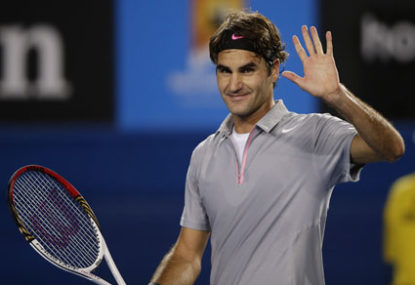Sweet revenge for Rafa as de Minaur downed to keep legend's Madrid fairytale alive
Alex de Minaur has missed out on the chance of a lifetime to beat Rafael Nadal on clay in successive tournaments, blown away by…

Tennis is a beautiful game. The very words of the game encompass so much of life. Service. Receive. Love.
Millions of people around the world play this back-and-forth dance that brings us together like few other sports. It is loved and played by young and old, boys and girls, amateurs and pros. To learn this game is a gift for life.
It pains me to admit this, but despite all the gifts this sport delivers, it isn’t perfect -especially for the pros.
Sure it looks squeaky clean. The current crop of men’s champions are a sponsor’s wet dream.
A well-dressed Swiss man plays some elegant strokes, shakes hands affably with a Serbian or Spanish counterpart, then kindly thanks the crowd for being so polite as to watch in silent awe during the point.
The tournament hands over a big, shiny trophy and a novelty-sized winner’s cheque with a year’s salary scribbled on it.
Everyone goes home happy and the players all jet set to the next tournament where luxury hotels, player parties, and endless prize-money await them.
This is true for a very select group of players, lucky enough to be at the pointy end of tennis echelons. They are, however, just a slither of the pie that makes up what is the ATP (Association of Tennis Professionals), the governing body of men’s professional tennis.
The reality of men’s tennis is that it is one of the most top-heavy paid sports in the world. This infographic from the Wall Street Journal highlights just how severe the drop off in prize money is for tennis. http://graphics.wsj.com/us-open-32/
Of the 32 top paid athletes in baseball, basketball, golf, NASCAR and hockey, tennis has the most severe decline in prize money by quite a margin.
Let’s be clear on one thing, the 32nd ranked player in tennis is actually quite a good player. In the 2014 infographic above it happened to be Fernando Verdasco, the Spaniard who defeated Rafael Nadal on Tuesday in the first round of the Australian Open.
A first-round loser at this year’s Australian Open takes home $34,500 (AUD), while the winner will pocket a cool $3.8 million. Sure the winner deserves a lot more than the 63 other first round losers, but does the ATP want a healthy tour or a healthy top ten?
Players who win grand slams make a lot more money off the court than they do on it. According to Forbes, Roger Federer made $9 million in prize money and salary last year, and a whopping $58 million in endorsements.
Does he really need all $9 million in prize money? If prize money was divvied out in a more even manner, you would have a sport that is feasible for more than 100 players. The ATP has made efforts in the last few years to get more money to those losing earlier in the tournament, but the process is moving slowly.
This disparity of fortune among professional players has meant that match-fixing is a very real concern in what can be a grinding and lonely occupation with no guaranteed paychecks.
It has been acknowledged that players lower in the ranks are at greater risk to match-fixing given the appalling prize money offered for lower and mid-tier events.
The BBC and Buzzfeed released a report on Monday of match-fixing allegations involving top players, some who had been top 50 at one point in their careers, as well as a grand slam champion.
‘Allegations’ is the word being used, in a story full of smoking guns and no arrests.
It’s not easy to provide concrete evidence in an area of occupation designed for unknown outcomes. After all, the reason people watch sport is because it’s supposed to be unscripted. Sure you have an idea of who should win, but we watch to see the upset, the drama, and the possibility of anything. A player who fixes a match always has this argument to fall back on.
You would have to be naïve to think that it isn’t more prevalent the lower you go down the rankings, with players struggling to make ends meet, the temptation would be heavy.
The redistribution of prize-money wouldn’t eradicate match-fixing from the sport completely, but it can certainly help. Tennis will always be prone to a player accepting easy money in a moment of moral weakness and financial insecurity on their back, but the current system only promotes this behaviour with its capitalist mentality.
The benefits of a more equal payout are far-reaching. More players can make professional tennis a feasible reality. These players can then afford the same luxuries that top players enjoy to get an edge. Full-time coaches, trainers, agents and expensive gluten-free diets.
Furthermore, the overall quality of a player’s tennis, and more importantly, their life, will be improved. Finally, the very top players still make an incredible fortune from endorsements.
Tennis continues to produce players that are often some of the richest athletes in the world. Federer, Nadal and Novak Djokovic all enjoy incredible endorsements from various companies around the globe. They can still enjoy this good fortune with less prize-money in the back-end of major events.
Tennis is a sport that can be played casually by all, and seriously by few. If the sport wants to survive in the 21st century, it will need to show that it can compete with other sports by supporting more than a handful of players.